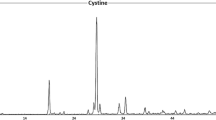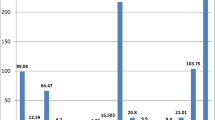Summary
In this study we compared the concentrations of calcium, iron, copper and zinc in the nucleus and the crust parts of various kinds of urinary calculi. We found that the mean concentrations of iron, zinc and copper in the nucleus parts of the stones were statistically higher than those in the crust parts. We attempted to explain this finding by two different approaches. Inter-and intracorrelations were also sought between the elements in the nucleus and crust parts. These correlations suggested a complex relationship between the elements of the urinary calculi.
Similar content being viewed by others
References
Abraham PA, Smith CL (1987) Evaluation of factors involved in cadium stone formation. Mineral Electrolyte Metab 13:201
Been JM, Mills PM, Levis D (1979) Microstructure of gallstones. Gastroenterology 76:548
Chiara G, Kurusawa N, Takasaki E (1959) Medical and biochemical application of infrared absorption spectra. II. Studies on urinary stone by infrared spectra. Chem Pharm Bull 7:622
Durak I, Yasar A, Yurtarslani Z, Akpoyraz M, Tasman S (1988) Analysis of magnesium and trace elements in urinary calculi by atomic absorption spectrophotometry. Br J Urol 62:203
Durak I, Kilic Z, Perk H, Sahin A, Yurtarslani Z, Yasar A, Küpeli S, Akpoyraz M (1990) Iron, copper, cadmium, zinc and magnesium contents of urinary tract stones and hairs from the men with stone disease. Eur Urol 17:243
Durak I, Sahin A, Perk H (1990) Smoking, hair cadmium and urinary tract stones. Eur Urol 17:267
Durak I, Akpoyraz M, Sahin A (1991) Sodium, potassium and chloride concentrations in the inner nucleus and outer crust parts of the urinary tract calculi. Int Urol Nephrol 23:221
Durak I, Kilic Z, Sahin A, Akpoyraz M, Atakurt Y (1991) Calcium and magnesium concentrations in the inner, nucleus and outer crust parts of urinary calculi. J Med School Ankara Univ 13:(in press)
Elliot SJ (1973) Structure and composition of urinary calculi. J Urol 109:82
Elliot JS, Eusebio E (1967) Calcium oxalate solubility: the effect of trace metals. Invest Urol 4:428
Etsuji T (1971) An observation on the analysis of urinary calculi by IR, Calcif Tissue Res 7:232
Hesse A (1974) Quantitative determination of the components of urinary stones through the use of IR spectroscopy. Z Urol Nephrol 67:367
Hesse A, Dietze HJ, Berg W, Hienzchh E (1977) Mass spectrometric trace element analysis of calcium oxalate uroliths. Z Eur Urol 3:359
Kirkbright GF (1980) Atomic absorption spectroscopy. Elemental analysis of biological materials. Technical Report Series No. 197. International Atomic Energy Agency, Vienna, p 141
Levinson AA, Nosal M, Davidman M, Prien EL Sr, Prien EL Jr, Stevenson RG (1978) Trace elements in kidney stones from three areas in the United States. Invest Urol 15:270
Meyer LJ, Angino EE (1977) The role of trace metals in calcium urolithiasis. Invest Urol 14:347
Meyer JL, Smith LH (1975) Growth of calcium oxalate crystals. II. Inhibition by natural urinary crystal inhibitors. Invest Urol 13:36
Robertson WG (1976) Urolithiasis research. Plenum Press, New York, p 5
Schneider HJ (1985) Morphology of urinary tract concretions. In: Schneider HJ (ed) Urolithiasis: etiology-diagnosis. Springer, Berlin Heidelberg New York, p 23
Sutor DJ, Wooley SE (1970) Growth studies of calcium oxalate in the presence of various compounds and ions. Br J Urol 44:296
Taylor BE, Saied SA (1982) Trace elements analysis of urinary calculi using proton induced X-ray emission (PIEE). Br J Urol 54:346
Welshman SG, McGeown MG (1972) A quantitative investigation of the effects of the growth of calcium oxalate crystals on potential inhibitors. Br J Urol 44:677
Author information
Authors and Affiliations
Rights and permissions
About this article
Cite this article
Durak, I., Kilic, Z., Sahin, A. et al. Analysis of calcium, iron, copper and zinc contents of nucleus and crust parts of urinary calculi. Urol. Res. 20, 23–26 (1992). https://doi.org/10.1007/BF00294330
Accepted:
Issue Date:
DOI: https://doi.org/10.1007/BF00294330




